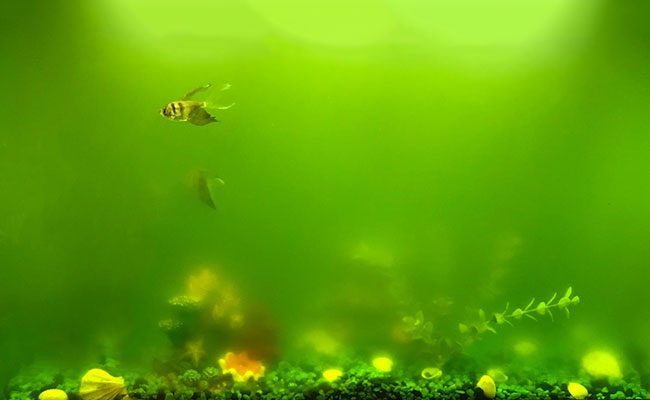Real aquarium algae control is not accomplished by dumping chemicals into the tank. While chemicals may destroy the algae, in the long-term they worsen the conditions in the aquarium, making renewed outbreak more likely. Dead algae increase the accumulating organic waste in the aquarium, leading to an increase in nitrate. It is well established that nitrate is the primary cause for algae growth within the fish tank.
Algae is only the symptom. Nitrate is the REAL cause of algae growth. Nitrate, resulting from the breakdown of organic waste, is the cause and therefore the real problem in the aquarium.
Since this is a one-way downward spiral, once we understand the environment and accept that there will always be some algae in the system, we can approach algae control in a much more effective way. Furthermore, algae are part of a healthy aquatic environment and are an important supplemental food source for many species. Algae are always present: either naturally (in the form of spores), or by catching a ride on newly purchased ornaments, fish, and plants. There, they patiently wait for favorable conditions that will lead to their explosive and destructive outbreak, causing numerous problems.
Algae cannot be completely eliminated from the aquarium no matter how big the effort. However, outbreaks can and should be controlled to maintain tank health. Instead of trying to eliminate algae by treating the symptoms, it is far more effective to focus on the cause. Successful algae control requires controlling the aquatic environment; thus avoiding an outbreak and the subsequent algae treatment.
Prevention is possible by avoiding a favorable environment that allows excessive algae growth. Algae growth relies on water and light, as well as other contributing factors such as: nitrates, organic and inorganic pollutants, phosphates, silicates, and iron. Since eliminating water from the aquarium is not an option, light and contributing factors must be controlled and adjusted. Freshwater aquarium florescent light bulbs must be changed every 6-9 months. The gasses in the bulb shift over time and encourage algae growth.
Because it takes time, the hobbyist does not always easily recognize the cause of an algae outbreak. Uneaten food particles picked up by the aquarium filter will have the same effect as particles settled on the substrate unless the filter is regularly rinsed or replaced and the waste is removed from the system. Too many fish increase pollution in the aquarium, also increasing the chances of algae growth. Healthy stocking rates are at about one inch of fish per fifteen square inches of water surface. A good feeding guideline is to feed what fish can eat in approximately one minute once a day. Regular aquarium maintenance should include partial water changes of 10-20% every other week in addition to vacuuming the gravel and rinsing the filters. Combined with timely replacement of the lighting, algae can be reasonably controlled. Algae-eating fish and critters prefer fresh and soft algae which are often not the ones that are a visible problem and a nuisance. Algae eaters are therefore part of the preventative measure, but not part of the solution once the algae are out of control. Adding new fish to an already algae-infested aquarium will likely worsen the problem as more waste will be produced, and the aquariums’ bio-filter will need to adjust for the change in bio-load.
Despite following all of the above, avoiding algae outbreaks can still be very challenging. An aquarium is a delicate environment which needs regular attention. Often our busy lifestyles make consistent maintenance a challenge. So from time to time “it just happens”!
When an outbreak does occur, don’t fall for the quick fix! There are some products, such as algaecides, which appear to offer a fast solution to the problem. Common ones are simazine, copper, and surfactants. No matter the marketing, the facts often remain undisclosed and many chemical compounds in algaecides will remain in the water for years. The detrimental effects are often only discovered much later, and are no longer associated with the past use of these chemicals. Use of these chemicals will do nothing to actually fix the cause of algae outbreaks and will in no way heal the tank. The problem is therefore likely to return at any time.
